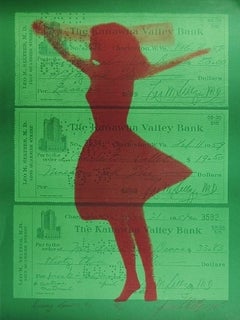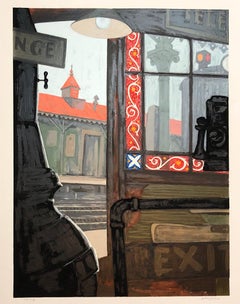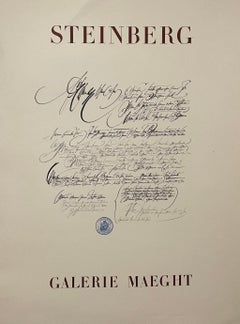Want more images or videos?
Request additional images or videos from the seller
1 of 9
James DarumNative American Indian Family, Old Southwest Silkscreen Lithograph James Darum
Price:$450
$500List Price
About the Item
- Creator:James Darum (American)
- Dimensions:Height: 24 in (60.96 cm)Width: 30 in (76.2 cm)
- Medium:
- Movement & Style:
- Period:
- Condition:
- Gallery Location:Surfside, FL
- Reference Number:1stDibs: LU38210563392
About the Seller
4.9
Platinum Seller
Premium sellers with a 4.7+ rating and 24-hour response times
Established in 1995
1stDibs seller since 2014
1,824 sales on 1stDibs
Typical response time: 1 hour
Authenticity Guarantee
In the unlikely event there’s an issue with an item’s authenticity, contact us within 1 year for a full refund. DetailsMoney-Back Guarantee
If your item is not as described, is damaged in transit, or does not arrive, contact us within 7 days for a full refund. Details24-Hour Cancellation
You have a 24-hour grace period in which to reconsider your purchase, with no questions asked.Vetted Professional Sellers
Our world-class sellers must adhere to strict standards for service and quality, maintaining the integrity of our listings.Price-Match Guarantee
If you find that a seller listed the same item for a lower price elsewhere, we’ll match it.Trusted Global Delivery
Our best-in-class carrier network provides specialized shipping options worldwide, including custom delivery.You May Also Like
"Balcony" 1938 WPA Print Mid 20th Century American Broadway Theatre Modernism
By Leon Bibel
Located in New York, NY
"Balcony" 1938 WPA Print Mid 20th Century American Broadway Theatre Modernism.
Silk screen on paper, 15” x 20". Numbered 15/20 lower left. Pencil si...
Category
1930s American Modern Figurative Prints
Materials
Paper, Screen
"Gold and Blue Gun" 1970s Original Portrait Silkscreen
Located in Arp, TX
Artist unknown
"Gold and Blue Gun"
c. 1970s
Silkscreen on paper
Image size 21.25"x17" paper size 26"x40" unframed $350
Unsigned
*Listed price reflects custom framing selected by sell...
Category
1970s American Modern Figurative Prints
Materials
Paper, Screen
Original "Wagon Lits" pop art style serigraph travel by train poster
By Valerio Adami
Located in Spokane, WA
Original “Wagon Lits” serigraph poster by the artist Valerio Adami.
It was printed in France by GrafiCaza (Michel Caza), one of the finest serigraph companies on woven paper—in exce...
Category
1990s American Modern Figurative Prints
Materials
Screen
$260 Sale Price
20% Off
H 36 in W 24 in D 0.05 in
Original Les Codes de CHANEL (black version) French fashion perfume poster
Located in Spokane, WA
Original Les Codes de CHANEL Poster – Black Fashion Wall Art, Modern Luxury Décor, Iconic Designer Brand Print for Bedroom, Living Room, Glam Office poster. Archival linen backed in ...
Category
Early 2000s American Modern Figurative Prints
Materials
Screen
$400
H 28 in W 22 in D 0.3 in
Original Les Codes de CHANEL French fashion poster
Located in Spokane, WA
Original Les Codes de CHANEL Poster – Pink Fashion Wall Art, Modern Luxury Décor, Iconic Designer Brand Print for Bedroom, Living Room, Glam Office poster. Archival linen backed in...
Category
2010s American Modern Figurative Prints
Materials
Screen
Original Mardi Gras New Orleans 1978 festival serigraph poster
Located in Spokane, WA
Original Mardi Gras, New Orleans, 1978 linen-backed poster. Dressed up in what would be an American Indian costume with full headgear, he is holding a shield with a horse on it. Indian decoration on the footwear. Signed and numbered.
I believe this has to deal with Big Chief leading his Congo Nation Mardi Gras Indian group. Zulu Parade. Many of the original Mardi Gras jazz posters...
Category
1970s American Modern Figurative Prints
Materials
Screen
$636 Sale Price
20% Off
H 32 in W 23 in D 0.05 in
Original USSR USA Superman superpowers original vintage poster
By Roman Cieslewicz
Located in Spokane, WA
Original 1968 Cold War Superman Style Poster by Roman Cieslewicz USSR / CCCP USA. Created as the cover of the French left-wing art magazine ‘Opus Internatio...
Category
1960s American Modern Portrait Prints
Materials
Screen
$1,100
H 32.5 in W 21.5 in D 0.05 in
Original Continental Airlines limited edition Serigraph vintage travel poster
Located in Spokane, WA
Original Continental Airlines travel poster. Linen backed in fine condition. Signed and numbered 35/50.
This original Continental Airlines poster is an artistic representation of regional destinations prominently served by Continental Airlines in the past. The design is modern and bold, showcasing a unique black-and-white theme with strong, futuristic typography and graphical illustrations. Each city is creatively depicted using stylized imagery that resonates with its character—Oklahoma City features a cowboy motif, New Orleans embraces a jazzy, cultural essence, Dallas reflects the energy of movement, and Midland/Odessa highlights industrial and oil-centric themes.
This limited-edition poster is printed in black and white. It features the destinations of Hawaii, San Francisco, Albuquerque and Portland Above each name is a design that represents each destination city.
Hawaii has rows of palm trees and hula dancers. San Francisco has rolling hills and cable cars. Albuquerque has tribal Indians dancing. Portland has the cruise shipping. This image features the Saul Bass l967 Continental logo in the design.
Continental Airlines was a major United States airline founded in 1934 and eventually headquartered in Houston, Texas.
The airline was acquired by UAL Corporation, the parent company of United Airlines, on October 1, 2010.
This is an original vintage Continental Airlines poster...
Category
Late 20th Century American Modern Figurative Prints
Materials
Screen
$675
H 40 in W 26.5 in D 0.3 in
Original British Columbia United Air Lines travel poster
Located in Spokane, WA
Behold the original British Columbia United Air Lines vintage Travel Poster—a rare gem from the mid-century Modern era. This archival linen-backed beauty is in excellent condition an...
Category
1960s American Modern Figurative Prints
Materials
Screen
Original Continental Airlines limited edition travel poster
Located in Spokane, WA
Original Continental Airlines travel poster. Linen backed in fine condition. Signed and numbered 35/50.
This original Continental Airlines poster artistically represents regional destinations prominently served by Continental Airlines in the past. The design is modern and bold, showcasing a unique black-and-white theme with strong, futuristic typography and graphical illustrations. Each city is creatively depicted using stylized imagery that resonates with its character—Oklahoma City features a cowboy motif, New Orleans embraces a jazzy, cultural essence, Dallas reflects the energy of movement, and Midland/Odessa highlights industrial and oil-centric themes.
This limited-edition poster is printed in black and white. It features Oklahoma City, New Orleans, Dallas, and Midland / Odessa destinations. Above each name is a design that represents each destination city.
Oklahoma City has rodeo horseback riding. New Orleans has steamships, Dallas has football players, and Midland has large oil tanker trucks. This image features the Saul Bass l967 Continental logo in the design.
Continental Airlines was a major United States airline founded in 1934 and eventually headquartered in Houston, Texas.
The airline was acquired by UAL Corporation, the parent company of United Airlines, on October 1, 2010.
This is an original vintage Continental Airlines poster...
Category
Late 20th Century American Modern Landscape Prints
Materials
Screen
$675
H 40 in W 265 in D 0.2 in
More From This Seller
View All1970s Pop Art "Dancing Lessons #2" Green, Pink Silkscreen Mod Ballet Girl Print
By Joanne Seltzer
Located in Surfside, FL
there is a companion piece on a silver paper. A depiction of a ballet dancer, superimposed upon canceled dance class checks.
Joanne Seltzer was born in Philadelphia, Pennsylvania a...
Category
1970s American Modern Abstract Prints
Materials
Screen
Modernist Silkscreen Screenprint 'El Station, Interior' NYC Subway, WPA Artist
By Anthony Velonis
Located in Surfside, FL
screenprint printed in color ink on wove paper. New York City subway station interior.
Anthony Velonis (1911 – 1997) was an American painter and designer born in New York City who helped introduce the public to silkscreen printing in the early 20th century.
While employed under the federal Works Progress Administration, WPA during the Great Depression, Velonis brought the use of silkscreen printing as a fine art form, referred to as the "serigraph," into the mainstream. By his own request, he was not publicly credited for coining the term.
He experimented and mastered techniques to print on a wide variety of materials, such as glass, plastics, and metal, thereby expanding the field. In the mid to late 20th century, the silkscreen technique became popular among other artists such as Robert Rauschenberg and Andy Warhol.
Velonis was born into a relatively poor background of a Greek immigrant family and grew up in the tenements of New York City. Early on, he took creative inspiration from figures in his life such as his grandfather, an immigrant from the mountains in Greece, who was "an ecclesiastical painter, on Byzantine style." Velonis attended James Monroe High School in The Bronx, where he took on minor artistic roles such as the illustration of his high school yearbook. He eventually received a scholarship to the NYU College of Fine Arts, into which he was both surprised and ecstatic to have been admitted. Around this time he took to painting, watercolor, and sculpture, as well as various other art forms, hoping to find a niche that fit. He attended NYU until 1929, when the Great Depression started in the United States after the stock market crash.
Around the year 1932, Velonis became interested in silk screen, together with fellow artist Fritz Brosius, and decided to investigate the practice. Working in his brother's sign shop, Velonis was able to master the silkscreen process. He reminisced in an interview three decades later that doing so was "plenty of fun," and that a lot of technology can be discovered through hard work, more so if it is worked on "little by little."
Velonis was hired by Mayor LaGuardia in 1934 to promote the work of New York's city government via posters publicizing city projects. One such project required him to go on a commercial fishing trip to locations including New Bedford and Nantucket for a fortnight, where he primarily took photographs and notes, and made sketches. Afterward, for a period of roughly six months, he was occupied with creating paintings from these records. During this trip, Velonis developed true respect and affinity for the fishermen with whom he traveled, "the relatively uneducated person," in his words.
Following this, Velonis began work with the Public Works of Art Project (PWAP), an offshoot of the Civil Works Administration (CWA), where he was assigned to serve the different city departments of New York. After the formation of the federal Works Progress Administration, which hired artists and sponsored projects in the arts, he also worked in theater.
Velonis began working for the federal WPA in 1935. He kept this position until 1936 or 1938, at which point he began working in the graphic art division of the Federal Art Project, which he ultimately led. Under various elements of the WPA program, many young artists, writers and actors gained employment that helped them survive during the Depression, as well as contributing works that created an artistic legacy for the country.
When interviewed in December 1994 by the Library of Congress about his time in the WPA, Velonis reflected that he had greatly enjoyed that period, saying that he liked the "excitement" and "meeting all the other artists with different points of view." He also said in a later interview that "the contact and the dialogue with all those artists and the work that took place was just invaluable." Among the young artists he hired was Edmond Casarella, who later developed an innovative technique using layered cardboard for woodcuts.
Velonis introduced silkscreen printing to the Poster Division of the WPA. As he recalled in a 1965 interview: "I suggested that the Poster division would be a lot more productive and useful if they had an auxiliary screen printing project that worked along with them. And apparently this was very favorably received..."
As a member of the Federal Art Project, a subdivision of the WPA, Velonis later approached the Public Use of Arts Committee (PUAC) for help in "propagandizing for art in the parks, in the subways, et cetera." Since the Federal Art Project could not be "self-promoting," an outside organization was required to advertise their art more extensively. During his employment with the Federal Art Project, Velonis created nine silkscreen posters for the federal government.
Around 1937-1939 Velonis wrote a pamphlet titled "Technical Problems of the Artist: Technique of the Silkscreen Process," which was distributed to art centers run by the WPA around the country. It was considered very influential in encouraging artists to try this relatively inexpensive technique and stimulated printmaking across the country.
In 1939, Velonis founded the Creative Printmakers Group, along with three others, including Hyman Warsager. They printed both their own works and those of other artists in their facility. This was considered the most important silkscreen shop of the period.
The next year, Velonis founded the National Serigraph Society. It started out with relatively small commercial projects, such as "rather fancy" Christmas cards that were sold to many of the upscale Fifth Avenue shops...
Category
1980s American Modern Figurative Prints
Materials
Screen
Vintage Poster Saul Steinberg Galerie Maeght Paris France
By Saul Steinberg
Located in Surfside, FL
SAUL STEINBERG (American 1914-1999) Via Air Mail Geometric Design Lithograph. Sheet: 21 1/2 x 28 inches; Frame: 22 1/4 x 29 inches. Plate signed and dated l/r with sticker upper ri...
Category
1970s American Modern Figurative Prints
Materials
Screen
Modernist Figurative Pop Art Etching and Aquatint "the Artist" Michael Mazur
By Michael Mazur
Located in Surfside, FL
Michael Mazur
"The Artist"
Hand signed and editioned from the edition of 50
1967
Michael Burton Mazur (1935-August 18, 2009) was an American artist who was described by William Grim...
Category
Early 2000s American Modern Abstract Prints
Materials
Lithograph, Screen
1970s Pop Art "Dancing Lessons #2" Silver Silkscreen Mod Ballet Girl Print
By Joanne Seltzer
Located in Surfside, FL
Printed on a slightly reflective metallic silver finished paper. there is a companion piece on a money green paper. A depiction of a ballet dancer, superimposed upon canceled dance c...
Category
1970s American Modern Portrait Prints
Materials
Screen
Location Proposal Iris Print Ed. 12 Architectural Study LA CAlifornia Modernist
By Cindy Bernard
Located in Surfside, FL
Cindy Bernard’s career spans nearly three decades and she is best known for photographs and projections that explore the relationship between cinema, memory, and landscape including the widely exhibited series Ask the Dust (1988-92), now in the collections of the Museum of Contemporary Art, Los Angeles (21 part set), the Pompidou, MOMA and the Whitney Museum of American Art. She is a recipient of grants and fellowships from the J. Paul Getty Trust Fund for the Visual Arts, California Arts Council, Creative Capital, Anonymous Was a Woman, the Harpo Foundation, California Community Foundation, the John Simon Guggenheim Memorial Foundation and the MacDowell Colony. Her work has been exhibited in museums and galleries in the US, Canada, Mexico, Europe, and Japan, and was included in the Whitney and Lyon Biennials.
In addition to her visual practice, Bernard takes an active interest in the spaces and production of social exchange. She was a director and advisor to Foundation for Art Resources from 1985 to 1990, a founding director of the Coalition for Freedom of Expression, and co-founder of MOCA Mobilization. Bernard is also the founder and director of The Society for the Activation of Social Space through Art and Sound (SASSAS), an organization she began in response to the need for a flexible and sustainable association dedicated to experimental music in Los Angeles. She has curated and produced more than 50 concerts for SASSAS including Welcome Inn Time Machine for Pacific Standard Time in 2012.
Her interest in sound has spurred several projects including a series of photographs of municipal band shells which Bernard sees as an architecture of public exchange and The Inquisitive Musician, an adaptation of a 17th century German satire, Musicus Curiosus, or Battalus, the Inquisitive Musician; the Struggle for Precedence between the Kunst Pfeifer and the Common Players. The Inquisitive Musician pits itinerant “beer fiddlers” against the city sanctioned “Kunstpfeifer” in an argument over who has the right to perform and be compensated. Presented as a staged reading incorporating video and live music, The Inquisitive Musician has been performed in New York, in Los Angeles at the LA County Museum of Art, and most recently at the Stedelijk Museum in Amsterdam in June 2013.
Current projects include Vinland, a meditation on the complex and continually shifting relationships between spaces, social and economic structures, and personal and collective histories and, more recently, an “episodic” series based on the history of social nudism: Your Personal View of (Social) Nudism.
Bernard is a Adjunct Professor of Graduate Fine Art at Art Center College of Art and Design and was appointed the inaugural Ruffin Distinguished Artist-In-Residence at the University of Virginia for the academic year 2013/2014. She was a 2016 National Endowment for the Arts Fellow at the MacDowell Colony and will be in residence at the UCross Foundation in 2017.
Muse X Editions. An (now defunct) LA based innovative publisher of limited-edition prints, Muse X has launched its first group of prints and is just beginning to make itself known to artists, curators, dealers and collectors. Among works just off the press are otherworldly landscapes by Barbara Kasten and Oliver Wasow, a sizzling sunset by Peter Alexander, abstract compositions by Pauline Stella Sanchez and Jennifer Steinkamp, text and photo combinations by Bill Barminski and Nancy Dwyer...
Category
1990s American Modern Landscape Prints
Materials
Color
Recently Viewed
View AllMore Ways To Browse
Southwest Indian Art
Native American Indian Prints
Southwest Lithographs
Raphael Soyer On Sale
Romero Britto On Sale
Salvador Dali 1968
Salvador Dali Woman
Signed Mr Brainwash
Vintage Crawling Baby
Woodblock Print Yoshitoshi
Aneta Szoltis Mencina
Aristide Bruant
Blanes Vintage
G Albert
Goya Los Desastres De La Guerra
Henri Lautrec Circus
Huckleberry Finn
Irreverent Art



